From June 28 to July 2, Rita and I took an East Coast stadium bus tour organized by Triple Crown Travel. It was hosted by two very nice guys, and we can recommend the experience – at least for baseball nuts. Among the other 39 on our bus were fans of the Cubs, Pirates, Mariners, Red Sox, Indians, Dodgers and Angels. Some highlights:
Nationals Park: The Montreal Expos moved to Washington D.C. in 2005. The team became the Washington Nationals and initially played in RFK Stadium, the former home of the Senators who had moved to Texas in 1961. The Nationals moved to their new stadium in 2008, and it even looks good in the rain. We had two rain delays that created a 5-hour game. But we got a rainbow and a home run by Bryce Harper for the winning home team.
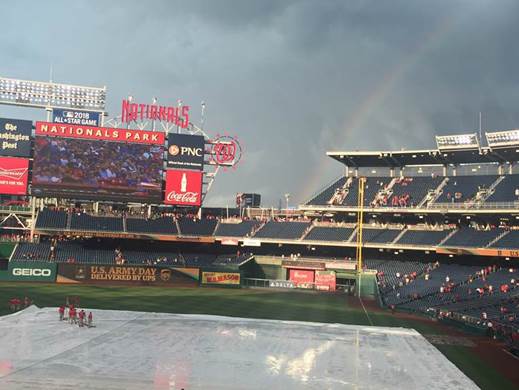
One of my favorite features of this park is the “Ring of Honor” on the façade above the press box. As discussed in Hot Stove #16, Washington has been home to two major league teams known as the Senators (now the Twins and Rangers) plus the current team that moved from Montreal. Also, the Homestead Grays of the Negro Leagues played many of their games in DC. The current Washington team is too new to have developed its own Hall of Famers, but members of the HOF from the other teams are honored with their names and numbers on the Ring of Honor. The 19 names include Walter Johnson, Harmon Killibrew, Cool Papa Bell, Josh Gibson, Andre Dawson and manager Frank Robinson.
Camden Yards: We left DC the next morning for Baltimore to tour Camden Yards. The Orioles were on the road and so we did not see a game. When this park opened in 1992, it received rave reviews for its retro look. Rita and I went to a game here in the mid-90’s and were very impressed. It still looks great. Our guide pointed out two seats that are painted orange to mark the landing spots of two landmark homeruns: (i) Cal Ripken’s 278th, breaking Ernie Banks record for homers by a shortstop, and (ii) Eddie Murray’s 500th homerun. Hall of Famers for the Orioles are honored with statues in a sculpture park near the stadium entrance.
One of the key visuals is the old warehouse beyond the right field fence. The street in front of the warehouse is Eutaw Street which becomes a festive fan area during the games. There have been 85 homers that have landed on Eutaw Street, but no regular game homer has hit the warehouse on the fly (Ken Griffey, Jr. hit the warehouse during the 1993 home run derby). For each Eutaw Street homer, there is a plaque to show where the ball landed. Rita and I found the only one marking a Royals homer – Alex Gordon who hit one of the longest at 425’ (click here for the video).
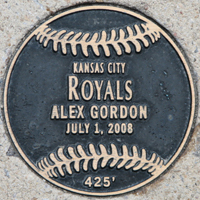
After the tour, Rita and I walked over to the Babe Ruth Museum housed in the home where the Babe was born in 1895. It is close to Camden Yards and you get there by following a trail of 60 baseballs painted on the sidewalk – to match his record home run number from 1927. Babe first played professionally for his hometown minor league team, and his contract was sold to the Red Sox in July of 1914. One thing you learn at the museum is that Ruth’s father ran a series of saloons in Baltimore, and one was located in what is now part of center field at Camden Yards. The photo below was taken after Babe’s 1915 season with the Red Sox and shows the Babe with his father at another one of his father’s Baltimore saloons.
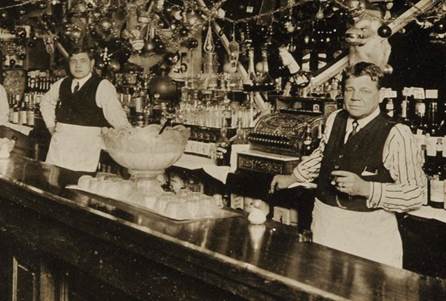
Ruth moved on to the Yankees in 1920, and after the team moved into the new Yankee Stadium in 1923, the ballpark became known as “The House that Ruth Built.” Leading us to our next stop…
New Yankee Stadium: The stadium made famous by Ruth was replaced by a new Yankee Stadium in 2009. Rita and I had previously been to both the old and new stadiums, so we passed on the Yankee game. We could not resist the allure of seeing Hamilton again on Broadway, and the timing was perfect because much of the original cast was leaving within a couple of weeks. While we were being mesmerized by Hamilton, the rest of our group saw quite a game between the Yankees and Rangers. The Rangers led 7-3 going into the bottom of the 9th, but NY hit two homers and scored 6 runs to win 9-7.
Citi Field: We saw the Mets play the Cubs on the field where the Royals won the World Series eight months ago. After the Cubs took an early lead with a Kris Bryant homer (with Zobrist on base), the Mets came back with a Cespedes homer and a rally helped by a Cubs error. For our group’s third game in a row, the home team won. About the 3rd inning, Rita and I went in search of food, but every concession stand (and there were lots of them) seemed to have a line of over 50 people. We finally found a short line at the “healthy” choice stand where we got a good sub. “Ball Park” food with lots of grease is clearly more popular. As we saw during the World Series, Mets fans sing along with Billy Joel to “Piano Man” in the 8th inning. This photo shows Cespedes on the scoreboard crossing the plate after his homer.
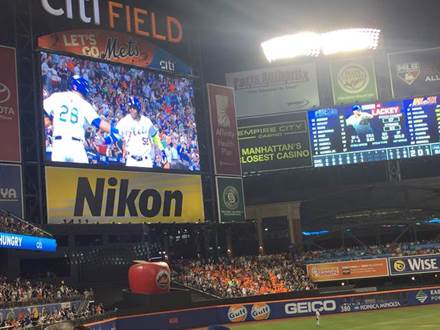
Fenway Park: The accolades for this jewel of a ball park are all deserved. It opened in 1912, two years earlier than Wrigley. The next oldest ballpark is Dodgers Stadium (1962). Quite a spread. Kauffman is the 6th oldest (1973). Although Fenway is old, it has been refurbished and seats have been added atop the Green Monster and along the roof to bring the capacity to 37,947 (Kauffman is 37,903).
Our afternoon tour took us to the far reaches of the stadium, including a view from atop the Green Monster in left field. The guide explained that the wall was first raised to keep fans from seeing the games from the neighborhood buildings, but it was increased to its 37-foot height to keep balls from leaving the park and breaking windows and windshields. At one time, the wall was covered completely with ads, but they distracted a famous left-handed hitter, both while at bat and when he was playing a ball off the wall. Ted Williams got his way. In 1947, the ads were stripped off and the wall was painted green and became known as the Green Monster. In 1940, owner Tom Yawkey also had Williams in mind when he relocated the bullpens to an area in front of the right field bleachers. This reduced the distance needed for a Williams’ homer by 23 feet. The sportswriters started calling the bullpens “Williamsburg” – where many of Ted’s homers landed.
Ted is also the only player to have a seat painted red to mark a home run at Fenway – the longest ever recorded at the park. It was hit in 1946. The seat is 502’ from home plate, and the estimated distance that it would have traveled unobstructed is 520-535 feet. It made Joe Boucher famous – he was the fan in the seat, and the ball broke his straw hat when it hit him on the head. I took a photo from the roof section and the camera angle placed the seat just below the #9 on the upper-deck display of Red Sox retired numbers. Ted was #9.
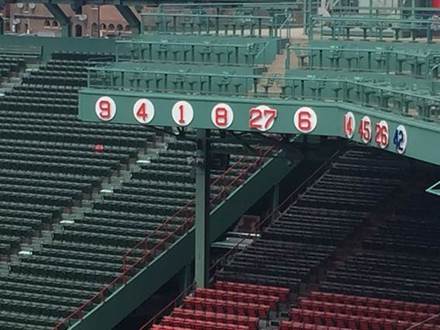
Our group’s streak of home wins fell apart at Fenway as the Angels humiliated the Red Sox 21-2 (three touchdowns for the Angels and a safety for Boston). The shellacking by the Angels did not keep the Red Sox fans from enjoying their traditional 8th inning sing-along – “Sweet Caroline” by Neil Diamond. We were treated to four homers over the Green Monster, one by future Hall of Famer Albert Pujols. It was not the most runs I had seen in a game. In 1955, the first year the A’s were in Kansas City, I went to a Saturday afternoon game with my dad. It was his first A’s game. The White Sox beat the A’s 29-6. He never went back.
The photo below was taken at the end of the game and you may be able to make out the 21-2 score on the 121-slot hand-operated scoreboard that sits at the foot of the Green Monster. Fenway has not yet taken the modern path of Wrigley which now has a huge electronic scoreboard. Fenway has a modest electronic screen in center, but the line score is still kept on the hand-operated scoreboard. This is also the only place to find scores of other games – often not kept up to date, so we had to check our phones to see if the Royals would come from behind (they did not). The yellow foul pole atop the Green Monster is the “Fisk Foul Pole” to honor Carlton Fisk who hit a 12th-inning walk-off homer to win Game 6 of the 1975 World Series. The ball appeared to be heading foul and Fisk famously jumped and waved his arms to urge the ball to stay fair. It did (click here). The celebration was short – the Reds won Game 7 the next night.
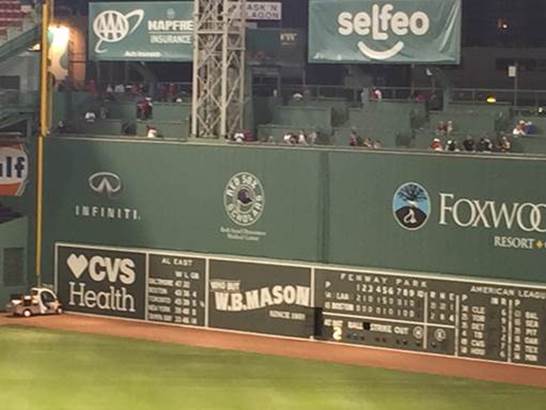
Populous of Kansas City: A common thread on the stadium trail was that the architect for the first four stadiums was Populous, a firm based in Kansas City. Populous was of course not in existence when Fenway was built, but the Red Sox hired them to do their spring training facility known as JetBlue Park at South Fenway. Rita and I were in Fort Myers a couple of years ago and went to a Red Sox/Cardinals game at JetBlue. It is an excellent facility and has the same field dimensions as Fenway and an almost-replica of the Green Monster. Populous is the original architect for 18 of the 30 existing stadiums and also has done the renovations for two others (including Kauffman). They are also the architect for the new stadium under construction in Atlanta.
Cooperstown – Baseball Hall of Fame: Between our stops in New York and Boston, we took a trip over to Cooperstown. We only had about five hours, but it was enough to appreciate the excellence of the museum. We plan to get back for a more leisurely look and also spend some time in the charming town. The nice thing about being there this year is that the World Series exhibit features the Royals. The centerpiece is Eric Hosmer’s jersey, still showing the dirt from his memorable slide into home to tie the game in the 9th inning of Game 5.
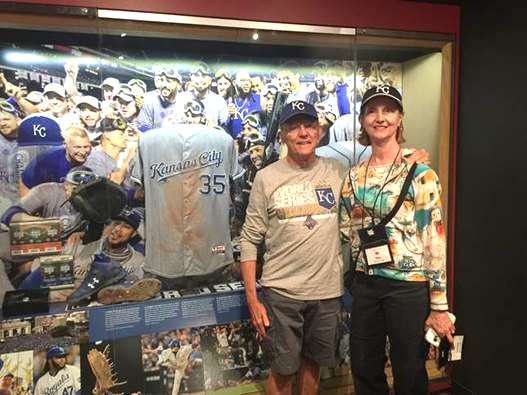
Another View of Fenway: After the Orlando shootings, I was taken by this visual of Fenway. Another poignant moment on Orlando was when Lin-Manuel Miranda accepted one of the Tony awards for Hamilton (click here).
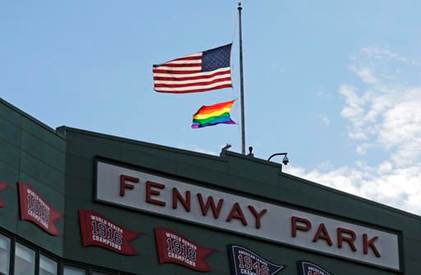
Netflix Note: I have previously mentioned the movie Fastball for your consideration. It is now on Netflix. The film compares the fastball speeds of Hall of Famers like Walter Johnson, Nolan Ryan and Bob Gibson with some of today’s flamethrowers. There are also interviews with some of the great hitters (including George Brett) on their opinions of the best fastball pitchers. Click here for the trailer – the first two voices you hear are Kevin Costner and Joe Posnanski.
Go Royals! (thanks to Salvy for the nice comeback last night)